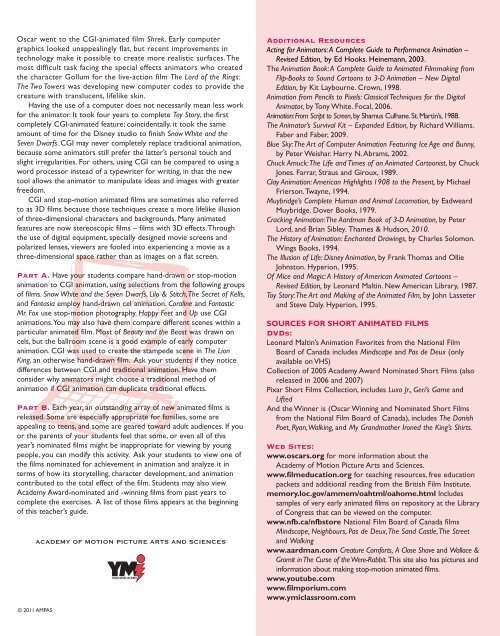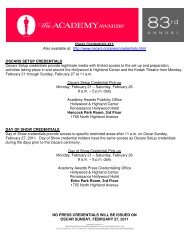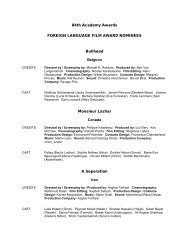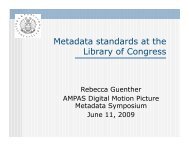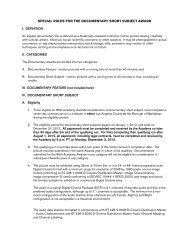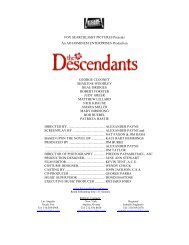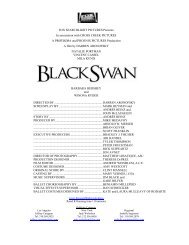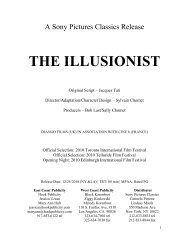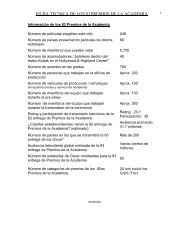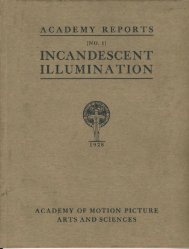CREATING MOVEMENT FRAME by FRAME - Academy of Motion ...
CREATING MOVEMENT FRAME by FRAME - Academy of Motion ...
CREATING MOVEMENT FRAME by FRAME - Academy of Motion ...
Create successful ePaper yourself
Turn your PDF publications into a flip-book with our unique Google optimized e-Paper software.
Oscar went to the CGI-animated film Shrek. Early computer<br />
graphics looked unappealingly flat, but recent improvements in<br />
technology make it possible to create more realistic surfaces. The<br />
most difficult task facing the special effects animators who created<br />
the character Gollum for the live-action film The Lord <strong>of</strong> the Rings:<br />
The Two Towers was developing new computer codes to provide the<br />
creature with translucent, lifelike skin.<br />
Having the use <strong>of</strong> a computer does not necessarily mean less work<br />
for the animator. It took four years to complete Toy Story, the first<br />
completely CGI-animated feature; coincidentally, it took the same<br />
amount <strong>of</strong> time for the Disney studio to finish Snow White and the<br />
Seven Dwarfs. CGI may never completely replace traditional animation,<br />
because some animators still prefer the latter’s personal touch and<br />
slight irregularities. For others, using CGI can be compared to using a<br />
word processor instead <strong>of</strong> a typewriter for writing, in that the new<br />
tool allows the animator to manipulate ideas and images with greater<br />
freedom.<br />
CGI and stop-motion animated films are sometimes also referred<br />
to as 3D films because those techniques create a more lifelike illusion<br />
<strong>of</strong> three-dimensional characters and backgrounds. Many animated<br />
features are now stereoscopic films – films with 3D effects.Through<br />
the use <strong>of</strong> digital equipment, specially designed movie screens and<br />
polarized lenses, viewers are fooled into experiencing a movie as a<br />
three-dimensional space rather than as images on a flat screen.<br />
Part A. Have your students compare hand-drawn or stop-motion<br />
animation to CGI animation, using selections from the following groups<br />
<strong>of</strong> films. Snow White and the Seven Dwarfs, Lilo & Stitch,The Secret <strong>of</strong> Kells,<br />
and Fantasia employ hand-drawn cel animation. Coraline and Fantastic<br />
Mr. Fox use stop-motion photography. Happy Feet and Up use CGI<br />
animations.You may also have them compare different scenes within a<br />
particular animated film. Most <strong>of</strong> Beauty and the Beast was drawn on<br />
cels, but the ballroom scene is a good example <strong>of</strong> early computer<br />
animation. CGI was used to create the stampede scene in The Lion<br />
King, an otherwise hand-drawn film. Ask your students if they notice<br />
differences between CGI and traditional animation. Have them<br />
consider why animators might choose a traditional method <strong>of</strong><br />
animation if CGI animation can duplicate traditional effects.<br />
Part B. Each year, an outstanding array <strong>of</strong> new animated films is<br />
released. Some are especially appropriate for families, some are<br />
appealing to teens, and some are geared toward adult audiences. If you<br />
or the parents <strong>of</strong> your students feel that some, or even all <strong>of</strong> this<br />
year’s nominated films might be inappropriate for viewing <strong>by</strong> young<br />
people, you can modify this activity. Ask your students to view one <strong>of</strong><br />
the films nominated for achievement in animation and analyze it in<br />
terms <strong>of</strong> how its storytelling, character development, and animation<br />
contributed to the total effect <strong>of</strong> the film. Students may also view<br />
<strong>Academy</strong> Award-nominated and -winning films from past years to<br />
complete the exercises. A list <strong>of</strong> those films appears at the beginning<br />
<strong>of</strong> this teacher’s guide.<br />
© 2011 AMPAS<br />
ACADEMY OF MOTION PICTURE ARTS AND SCIENCES<br />
Additional Resources<br />
Acting for Animators:A Complete Guide to Performance Animation –<br />
Revised Edition, <strong>by</strong> Ed Hooks. Heinemann, 2003.<br />
The Animation Book:A Complete Guide to Animated Filmmaking from<br />
Flip-Books to Sound Cartoons to 3-D Animation – New Digital<br />
Edition, <strong>by</strong> Kit Laybourne. Crown, 1998.<br />
Animation from Pencils to Pixels: Classical Techniques for the Digital<br />
Animator, <strong>by</strong> Tony White. Focal, 2006.<br />
Animation:From Script to Screen,<strong>by</strong> Shamus Culhane.St.Martin’s,1988.<br />
The Animator’s Survival Kit – Expanded Edition, <strong>by</strong> Richard Williams.<br />
Faber and Faber, 2009.<br />
Blue Sky:The Art <strong>of</strong> Computer Animation Featuring Ice Age and Bunny,<br />
<strong>by</strong> Peter Weishar. Harry N.Abrams, 2002.<br />
Chuck Amuck:The Life and Times <strong>of</strong> an Animated Cartoonist, <strong>by</strong> Chuck<br />
Jones. Farrar, Straus and Giroux, 1989.<br />
Clay Animation: American Highlights 1908 to the Present, <strong>by</strong> Michael<br />
Frierson.Twayne, 1994.<br />
Muybridge’s Complete Human and Animal Locomotion, <strong>by</strong> Eadweard<br />
Muybridge. Dover Books, 1979.<br />
Cracking Animation:The Aardman Book <strong>of</strong> 3-D Animation, <strong>by</strong> Peter<br />
Lord, and Brian Sibley. Thames & Hudson, 2010.<br />
The History <strong>of</strong> Animation: Enchanted Drawings, <strong>by</strong> Charles Solomon.<br />
Wings Books, 1994.<br />
The Illusion <strong>of</strong> Life: Disney Animation, <strong>by</strong> Frank Thomas and Ollie<br />
Johnston. Hyperion, 1995.<br />
Of Mice and Magic:A History <strong>of</strong> American Animated Cartoons –<br />
Revised Edition, <strong>by</strong> Leonard Maltin. New American Library, 1987.<br />
Toy Story:The Art and Making <strong>of</strong> the Animated Film, <strong>by</strong> John Lasseter<br />
and Steve Daly. Hyperion, 1995.<br />
SOURCES FOR SHORT ANIMATED FILMS<br />
DVDs:<br />
Leonard Maltin’s Animation Favorites from the National Film<br />
Board <strong>of</strong> Canada includes Mindscape and Pas de Deux (only<br />
available on VHS)<br />
Collection <strong>of</strong> 2005 <strong>Academy</strong> Award Nominated Short Films (also<br />
released in 2006 and 2007)<br />
Pixar Short Films Collection, includes Luxo Jr., Geri’s Game and<br />
Lifted<br />
And the Winner is (Oscar Winning and Nominated Short Films<br />
from the National Film Board <strong>of</strong> Canada), includes The Danish<br />
Poet, Ryan,Walking, and My Grandmother Ironed the King’s Shirts.<br />
Web Sites:<br />
www.oscars.org for more information about the<br />
<strong>Academy</strong> <strong>of</strong> <strong>Motion</strong> Picture Arts and Sciences.<br />
www.filmeducation.org for teaching resources, free education<br />
packets and additional reading from the British Film Institute.<br />
memory.loc.gov/ammem/oahtml/oahome.html Includes<br />
samples <strong>of</strong> very early animated films on repository at the Library<br />
<strong>of</strong> Congress that can be viewed on the computer.<br />
www.nfb.ca/nfbstore National Film Board <strong>of</strong> Canada films<br />
Mindscape, Neighbours, Pas de Deux,The Sand Castle,The Street<br />
and Walking<br />
www.aardman.com Creature Comforts, A Close Shave and Wallace &<br />
Gromit inThe Curse <strong>of</strong> theWere-Rabbit. This site also has pictures and<br />
information about making stop-motion animated films.<br />
www.youtube.com<br />
www.filmporium.com<br />
www.ymiclassroom.com


